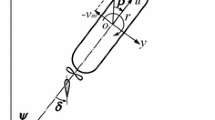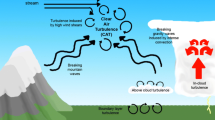Abstract
The autonomous operations of marine vehicles have recently attracted significant attention. In particular, automation of harbor operations, such as autonomous docking or berthing, is a challenging target. In low-speed harbor operations, the external disturbance of wind is a non-negligible factor. Therefore, the stochastic behavior of gusty wind should be considered in numerical simulations. This study presents a practical computational scheme for generating random wind velocity fields. In the proposed method, the von Kármán’s spectrum [1] and Hino’s wind speed spectrum [2] were fitted by a degree of freedom (1DoF) filter driven by the Wiener process. The corresponding Itô’s equation had the form of the Ornstein–Uhlenbeck process. By employing the analytical solution of the Ornstein–Uhlenbeck process, the wind process was successfully generated without time series repetition. Furthermore, the wind speed and direction processes were also generated from the measured drift and diffusion terms. The spectra of these numerical results are consistent with the observed spectra.











Similar content being viewed by others
References
von Kármán T (1948) Progress in the statistical theory of turbulence. Proc Natl Acad Sci 34(11):530
Hino M (1971) Spectrum of gusty wind. in Proceedings of the 3rd International Conference on Wind Effects on Buildings and Structures, Tokyo, Japan, vol. 77
IMO, International Code on Intact Stability 2008 (IMO publication,International Maritime Organization, 2009)
Schnelle KB (2003) in Encyclopedia of Physical Science and Technology (Third Edition), ed. by R.A. Meyers, third edition edn. (Academic Press, New York, 2003), pp. 679–705. doi:10.1016/B0-12-227410-5/00036-3. https://www.sciencedirect.com/science/article/pii/B0122274105000363
Miyauchi Y, Maki A, Umeda N, Dimas R, Akimoto M (2021) System parameter exploration of ship maneuvering model for automatic docking/berthing using cma-es
Davenport AG (1961) The spectrum of horizontal gustiness near the ground in high winds. Q J R Meteorol Soc 87(372):194
Ragwitz M, Kantz H (2001) Indispensable finite time corrections for fokker-planck equations from time series data. Phys Rev Lett 87(25):254501
Friedrich R, Renner C, Siefert M, Peinke J (2002) Comment on indispensable finite time corrections for fokker-planck equations from time series data. Phys. Rev. Lett. 89:14
Milan P, Wächter M, Peinke J (2014) Stochastic modeling and performance monitoring of wind farm power production. J Renew Sustain Energy 6(3):033119
Zárate-Minano R, Mele FM, Milano F (2016) Sde-based wind speed models with weibull distribution and exponential autocorrelation. in 2016 IEEE Power and Energy Society General Meeting (PESGM) (IEEE, 2016), pp. 1–5
Benth FE, Di Persio L, Lavagnini S (2018) Stochastic modeling of wind derivatives in energy markets. Risks 6(2):56
Akimoto Y, Miyauchi Y, Maki A (2021) Saddle point optimization with approximate minimization oracle and its application to robust berthing control
Belenky V (2011) Contemporary ideas on ship stability and capsizing in waves. Springer, Berlin, pp 589–597
Maruyama Y, Umeda N, Maki A (2022) Measures for avoiding self-repetition effect in the direct stability assessment. in International Ship Stability Workshop
Maki A (2017) Estimation method of the capsizing probability in irregular beam seas using non-gaussian probability density function. J Mar Sci Technol 22(2):351
Maki A, Sakai M, Umeda N (2019) Estimating a non-gaussian probability density of the rolling motion in irregular beam seas. J Mar Sci Technol 24(4):1071
Van der Hoven I (1957) Power spectrum of horizontal wind speed in the frequency range from 0.0007 to 900 cycles per hour. J Atmos Sci 14(2):160
Nichita C, Luca D, Dakyo B, Ceanga E (2002) Large band simulation of the wind speed for real time wind turbine simulators. IEEE Trans Energy Convers 17(4):523
Dostal L, Hollm M, Kreuzer E (2020) Study on the behavior of weakly nonlinear water waves in the presence of random wind forcing. Nonlinear Dyn 99:2319
Dostal L, Kreuzer E, Sri Namachchivaya N (2012) Non-standard stochastic averaging of large-amplitude ship rolling in random seas. Proc R Soc A Math Phys Eng Sci 468(2148):4146
Kloeden PE, Platen E (1992) Numerical solution of stochastic differential equations. Springer-Verlag, Berlin
Jing Q, Sasa K, Chen C, Yin Y, Yasukawa H, Terada D (2021) Analysis of ship maneuvering difficulties under severe weather based on onboard measurements and realistic simulation of ocean environment. Ocean Eng 221:108524
Sasa K, Terada D, Shiotani S, Wakabayashi N, Ikebuchi T, Chen C, Takayama A, Uchida M (2015) Evaluation of ship performance in international maritime transportation using an onboard measurement system-in case of a bulk carrier in international voyages. Ocean Eng 104:294
Sasa K, Faltinsen OM, Lu LF, Sasaki W, Prpić-Oršić J, Kashiwagi M, Ikebuchi T (2017) Development and validation of speed loss for a blunt-shaped ship in two rough sea voyages in the southern hemisphere. Ocean Eng 142:577
Kloeden PE, Platen E, Schurz H, Sørensen M (1996) On effects of discretization on estimators of drift parameters for diffusion processes. J Appl Probab 2:1061–1076
Gradisek J, Siegert S, Friedrich R, Grabec I (2000) Analysis of time series from stochastic processes. Phys Rev E 62(3):3146
Friedrich R, Peinke J, Renner C (2000) How to quantify deterministic and random influences on the statistics of the foreign exchange market. Phys Rev Lett 84(22):5224
Renner C, Peinke J, Friedrich R (2001) Experimental indications for markov properties of small-scale turbulence. J Fluid Mech 433:383
Buchbinder G, Chistilin K (2007) Multiple time scales and the empirical models for stochastic volatility. Phys A 379(1):168
Kriso S, Peinke J, Friedrich R, Wagner P (2002) Reconstruction of dynamical equations for traffic flow. Phys Lett A 299(2–3):287
Sura P, Barsugli J (2002) A note on estimating drift and diffusion parameters from timeseries. Phys Lett A 305(5):304
Karlin S, Taylor HE (1981) A second course in stochastic processes. Elsevier, Amsterdam
Miyauchi Y, Sawada R, Akimoto Y, Umeda N, Maki A (2021) Optimization on planning of trajectory and control of autonomous berthing and unberthing for the realistic port geometry
Fujiwara T, Ueno M (1998) Estimation of wind forces and moments acting on ships. J Soc Naval Arch Jpn 183:77
Acknowledgements
The authors would like to thank the referees for their detailed comment, helpful advises, and suggestions. This study was supported by a Grant-in-Aid for Scientific Research from the Japan Society for the Promotion of Science (JSPS KAKENHI Grant #19H02360, #19K04858, #20H02398). Furthermore, this work was partly supported by the JASNAOE collaborative research program/financial support. The authors are also thankful to Enago (www.enago.jp) for reviewing the English language.
Author information
Authors and Affiliations
Corresponding author
Ethics declarations
Conflict of interest
The authors declare that they have no conflict of interest.
Appendix
Appendix
In some studies, e.g., [5, 33], forces and moment acting on hull due to wind can be estimated using Fujiwara’s regression formulae [34]
where
Here, \(X_{A}\) is the surge directional wind force; \(Y_{A}\) is the sway directional wind force; \(N_{A}\) is the yaw directional wind moment; \(\rho _{A}\) is the density of air; \(A_{T},\ A_{L}\), and \(L_{OA}\) are the transverse projected area, lateral projected area, and the overall length of the ship, respectively. \(X_{i}, \ Y_{i}\), and \(N_{i}\) are the coefficients in the regression formulae [34]. These parameters can be estimated only from the geometric parameters of the ship.
About this article
Cite this article
Maki, A., Maruyama, Y., Dostal, L. et al. Practical method for evaluating wind influence on autonomous ship operations. J Mar Sci Technol 27, 1302–1313 (2022). https://doi.org/10.1007/s00773-022-00901-w
Received:
Accepted:
Published:
Issue Date:
DOI: https://doi.org/10.1007/s00773-022-00901-w




